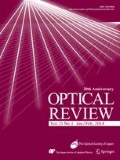Abstract
Adaptive image denoising method decomposes the original image into a series of basic pattern feature images on the basis of wavelet description and constructs the support vector machine regression function to realize the wavelet description of the original image. The support vector machine method allows the linear expansion of the signal to be expressed as a nonlinear function of the parameters associated with the SVM. Using the radial basis kernel function of SVM, the original image can be extended into a MEXICAN function and a residual trend. This MEXICAN represents a basic image feature pattern. If the residual does not fluctuate, it can also be represented as a characteristic pattern. If the residuals fluctuate significantly, it is treated as a new image and the same decomposition process is repeated until the residuals obtained by the decomposition do not significantly fluctuate. Experimental results show that the proposed method in this paper performs well; especially, it satisfactorily solves the problem of image noise removal. It may provide a new tool and method for image denoising.




Similar content being viewed by others
References
Li, S., Kwok, J.T., Wang, Y.: Combination of images with diverse focus using spatialfrequency. Inf. Fusion 2(3), 169–176 (2001)
Yue, H.M., Su, X.Y., Liu, Y.Z.: Fourier transform profilometry based on composite structured light pattern. Opt. Laser Technol. 39(4), 1170–1175 (2007)
Wang, P., Tian, H., Zheng, W.: A novel image fusion method based on FRFT-NSCT. Math. Prob. Eng. 2013, 1–10 (2013)
Hernandez, J.R., Amado, M., Perez-Gonzalez, F.: DCT-domain watermarking techniques for still image: detector performance analysis and a new structure. IEEE Trans. Image Process. 38(9), 55–68 (2000)
Solachidis, V., Pitas, I.: Circularly symmetric watermark embedding in 2D-DFT domain. IEEE Trans. Image Process. 10(11), 1741–1753 (2001)
Grossman, A., Morlet, J.: Decomposition of hardy functions into square Integrable wavelets of constants shape. SIAM J. Math. Anal. 15(4), 723–736 (1984)
Huang, N.E., Shen, Z., Long, S.R., Wu, M.C., Shih, H.H., Zheng, Q., Yen, N.C., Tung, C.C., Liu, H.H.: The empirical mode decomposition and the Hilbert spectrum for non-linear and non-stationary time series analysis. Proc R Soc Lond A 454(12), 903–995 (1998)
Nunes, J.C., Bouaouue, Y., Delechelle, E., et al.: Image analysis by bidimensional empirical mode decomposition. Image Vision Computing 21(3), 1019–1026 (2003)
Nunes, J.C., Guyot, S., Delechelle, E., Niang, O., Bunel, Ph: Texture analysis based on local analysis of the bidimensional empirical mode decomposition. Mach. Vis. Appl. 16(5), 177–188 (2005)
Chen, C.Y., Guob, S.M., Chang, W.S., Tsaic, J.S.H., Cheng, K.S.: An improved bidimensional empirical mode decomposition: a mean approach for fast decomposition. Signal Proc. 98, 344–358 (2014)
He, Z., Wang, Q., Shen, Y., Jin, J., Wang, Y.: Multivariate gray model-based BEMD for hyperspectral image classification. IEEE Trans. Instrum. Meas. 62(5), 889–904 (2013)
Yi, Zhou, Hongguang, Li: Adaptive noise reduction method for DSPI fringes based on bi-dimensional ensemble empirical mode decomposition. Opt. Express 19(19), 18207–18215 (2011)
LiHong, Qiao, KaiFu, Niu, Ning, Wang, Peng, LiZhong: Perfect reconstruction image modulation based on BEMD and quaternionic analytic signals. Sci. China Inf. Sci. 54(12), 2602–2614 (2011)
Hu, J., Wang, X., Qin, H.: Improved, feature-centric EMD for 3D surface modeling and processing. Graph. Models 76(5), 340–354 (2014)
Ye, Q., Xiang, M., Cui, Z.: Fingerprint image enhancement algorithm based on two dimension EMD and Gabor filter. Proc. Eng. 29, 1840–1844 (2012)
Van Tung, T., Yang, B.S., Gu, F., Ball, A.: Thermal image enhancement using bi-dimensional empirical mode decomposition in combination with relevance vector machine for rotating machinery fault diagnosis. Mech. Syst. Signal Proc. 38(2), 601–614 (2013)
Kopsinis, Y., McLaughlin, S.: Investigation and performance enhancement of the empirical mode decomposition method based on a heuristic search optimization approach. IEEE Trans. Signal Process. 56(1), 1–13 (2008)
Mallat, S.G.: A theory of multiresolution signal decomposition: the wavelet representation. IEEE Trans. Pattern Anal. Machine Intell. 11(7), 674–693 (1989)
Percival, D.B., Walden, A.T.: Wavelet Methods for Time Series Analysis. Cambridge University Press, Cambridge (2000)
Qian, S., Chen, D.: Signal representation using adaptive normalized Gaussian functions. Signal Proc. 36(1), 1–11 (1994)
Vapnik, V., Vashist, A.: A new learning paradigm: learning using privileged information. Neural Netw. 22(5), 544–557 (2009)
Acknowledgements
This work was supported by the National Science Foundation Project of P. R. China (nos. 61501026, 61701188 and 61272506).
Author information
Authors and Affiliations
Corresponding author
Rights and permissions
About this article
Cite this article
An, FP., Zhou, XW. Adaptive image denoising based on support vector machine and wavelet description. Opt Rev 24, 660–667 (2017). https://doi.org/10.1007/s10043-017-0360-9
Received:
Accepted:
Published:
Issue Date:
DOI: https://doi.org/10.1007/s10043-017-0360-9




